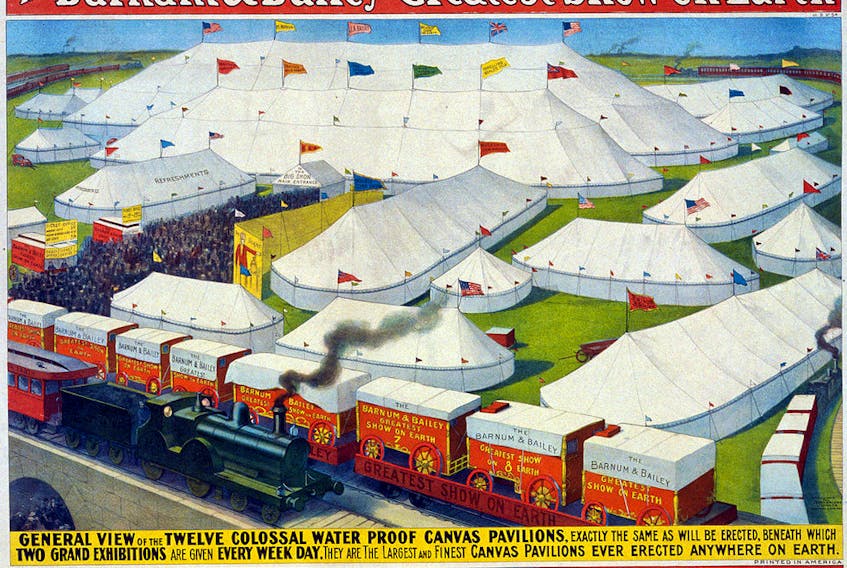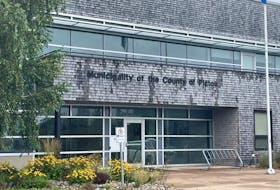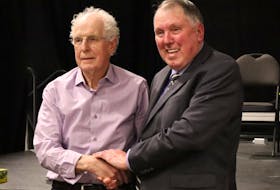WESTVILLE, N.S. — In the late 1800s and early 1900s Barnum and Bailey’s Circus was billed as The Greatest Show on Earth.
The touring circus entertained millions and was described as the head of the world amusement business and recognized in every country around the globe. A Pictou County man was instrumental in providing music and direction while travelling with this extravaganza throughout North America.
Charles B. (Charlie) Wilson of Westville was a gifted musician and had a deep passion and lifelong involvement with his chosen profession. He began his musical career at the age of eight, when he played cornet in a local concert directed by his father, back in the days when Westville was famous for its bands. Wilson became heavily involved in the entertainment industry early on when he joined a theatrical group and appeared before audiences in scores of cities and towns throughout the continent.
He eventually moved to United States in the year 1912 and secured a position with the Ringling Bros. Circus as their solo cornetist. In 1914, Wilson would obtain a job with Barnum and Bailey Circus as a cornetist and in 1915 became assistant circus bandmaster to conductor Edwin “Ned” Brill. Wilson reported he frequently had charge of the whole band when the aging bandmaster would take time off.
The circus brass band was a collection of 30 to 40 musicians who specialized in all types of music, especially marches. In the "old days," being a circus musician was a very strenuous job. In addition to playing non-stop for up to three hours for the main show, musicians were expected to play in the circus parade, a free concert for the townspeople, post-show concerts or sideshows on the grounds, and to mingle around the grounds before the big top event. Then, after everyone left, they helped take down the tents or do other chores around the grounds.
Interviewed in 1952 Wilson explained, “Band members were hired for whatever they’d take. We were approached by every musician and some of them were paid as little $15 dollars a week. As an assistant bandleader I got $28 a week and thought I was paid well.”
The time spent traveling with the circus was gruelling. Usually beginning in early April the entire entourage would leave their winter quarters at Bridgeport, Connecticut, where all the train cars, wagons, animals and winter staff were packed away.
According to Wilson, “it took 100 railway cars to move the outfit from one stand to another, precision like organization being required all along the line. First train out carried the cookhouse and a good many of the ‘roughnecks’ who did most of the bull work of the circus. The second train carted the ‘big top tents’ and the seats and gear carefully packed for quick setup as soon as the next city was reached.”
In the 1915 circus season began with a 24 day-night stint in New York City and then onto New Jersey, Philadelphia, Nebraska and for the next eight months travel just about anywhere in the mainland United States that had access to the railroad and space. The circus also made several visits into Canada. Usually in early November Barnum and Bailey Circus would pack up and head back to Bridgeport for a well-needed winter rest.
Building excitement

“Those were wonderful days in the circus world” explained Wilson “the trains were so heavy they required four engines on some areas running through the mountains – a thrilling sight to watch. We carried 600 horses with us – their feed bill was tremendous. But the human bill from the cookhouse must have been bigger. We were a band of over 1,400 people and had to be fed regularly three times a day.”
When “The Greatest Show on Earth” came to town, daily life abruptly stopped. Months before the show arrived, an advance team saturated the surrounding region with brilliantly coloured posters of the extraordinary: elephants, bearded ladies, clowns, tigers, acrobats and trick riders. Huge crowds gathered, families witnessed the raising of a tented city across nine acres.
“I think the biggest thrill was to the thousands of small children in every town that followed the circus parade. With all the horses we had and so many wagon, you can picture the length of the parade. It used to take 45 minutes to pass a given point: that is if nothing went wrong to hold things up,” Wilson recalled.
The circus band was always in the parade and usually divided into three units. Cornetist Wilson travelled in Bandwagon No. 1, along with conductor Ned Brill and an assortment of other musicians. In Wilson’s tenure with Barnum and Bailey, the No. 1 music coach was usually the 28 foot long (8.6 meters) Two Hemisphere Bandwagon which could accommodate 28 instrumentalists.
“In the parades we had our own special wagon-drawn by 12 horses in polished harness,” Wilson once said. “At first there were 24 horses but it was found too troublesome to get that many around corners.”
Wilson recalls having to jump from the bandwagon. “Those wagons were equipped with heavy hand breaks, but every now and then on a particular steep hill that had to be negotiated the brakeman would be a little slack. I had to jump a couple of times – no fun with the big vehicle lumbering away down the hill and frightened horses galloping to keep ahead.”
In 1916 Wilson ended his connection with Barnum and Bailey Circus and move to Clyde, New York, where he taught music. Opportunities abounded in the “City That Never Sleeps”, but Wilson became homesick and moved back to Nova Scotia. And in 1920, he married Florence May Brown. Wilson would spend the next number of years heavily involved in his music quest throughout Nova Scotia.
For several years he successfully directed the Royal Regimental Band in the Annapolis region of Nova Scotia and a report in the local 1932 Spectator newspaper stated, “Praise follows truth afar, last evening as I listened to the Annapolis Royal Regimental Band, now is the best band ever been able to boast of in its history, never to be forgotten. May I solicit through your gracious columns under the competent direction of Mr. Charlie Wilson, your heartiest co-operation and support, ever bearing in mind that what you have now is the best Annapolis Royal Band has ever been.”
During the Second World War, bandmaster Wilson was personally asked by Colonel J.L. Ralston, then Canada's minister of national defence, to organize the Aldershot Infantry Training Centre Band. Its members were of the famous old 85th and 78th Pictou Highlanders, 13 of whom hailed from Pictou County. In 1954 Wilson revived the 78th Memorial Band to rave reviews.
Wilson would have a life of constant activity not only in music but also sports. In the 1902 season he played for the Westville Hockey Club in the original Pictou County Hockey League and was a member of the Westville Curling Club for over 40 years.
This well-respected and well-liked and noted Westville bandmaster musician and sportsman, passed away in 1967 and is buried at Saint Philip's Cemetery, Westville.
John Ashton is a historical author, graphic and visual artist and operates a 34-year Nova Scotia registered business, Ashton Creative Design in Bridgeville, Pictou County. He may be reached at [email protected]
Historical research
Celebrating Our Heritage: The History of Westville - 1986
Westville Freelance, January 16, 1952
The Evening News - Charlie Stevens Column 1967
History of Watertown, Wisconsin
Circus History Society - Don Covington
Circus Historian - Charles Conrad
Wayland Middle School Music - Tidbit Circus Bands
Annapolis Heritage Society - Lois Jenkins
Nedra Wilson – Pictou County Roots Society
Daytona Beach Journal
Morris Campbell, Westville
History Magazine-Oct/Nov 2001
Circuses and Sideshows.com
www.circussideshows.com









